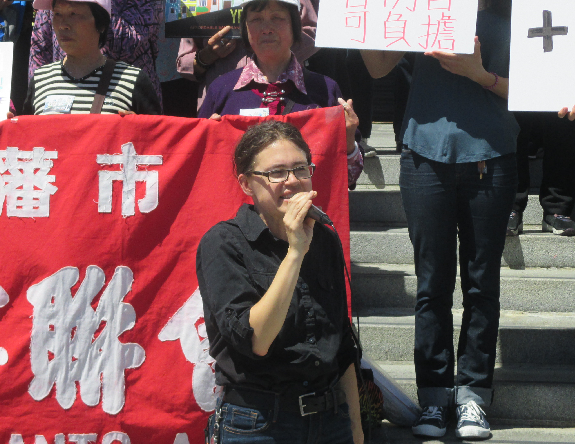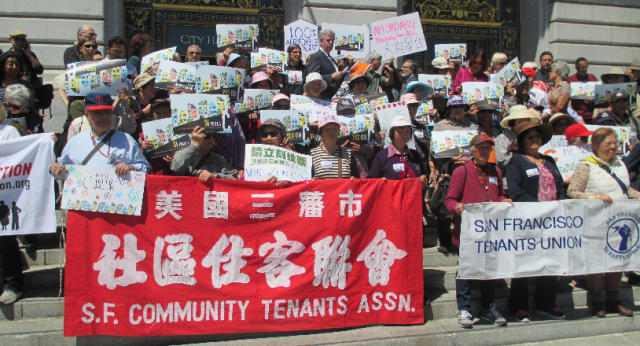Fred Sherburn-Zimmer, director of the Housing Rights Committee, stood on the steps of City Hall yesterday morning and explained why allowing the free market to set local housing policy makes no sense.

Every time a big market-rate housing project is dropped into a working-class community, she noted, evictions and rents go up all around it. After the Monster in the Mission was proposed (not even built), she said, tenants from all over the area were in her office complaining about rent hikes and eviction threats.
“If we get ten affordable housing units, and 100 people are displaced, we didn’t get shit,” she said.
Pretty simple.
The rally in support of a measure by Sups. Aaron Peskin and Eric Mar that would allow more density all over the city – but only for truly affordable housing – came a couple of days after I got into a big Twitter debate with Kim Mai-Cutler, she of the burrowing owls and vomiting anarchists, over my suggestion that big market-rate projects in the Mission and the Tenderloin won’t do much good for anyone except the developers and the wealthy.

Cutler, and the SFBARF people who agree with her, say that restrictive zoning has driven up land costs, making all housing too expensive. If we only allowed more housing of all sorts, eventually prices would come down.
And if what I tend to support, which is a complete shift to what is known in Europe as social housing – that is, housing that is never part of the private market – how the hell are we going to pay for it?
I argued that, in fact, if done right, restrictive zoning brings down property values – which ought to be the point. And I had a two-word solution to the money problem: Tax Zuckerberg.
But it’s hard to have this discussion in 140 characters, which is why I am not good at Twitter fights, so I thought I’d flesh the whole thing out a bit.
Zoning is a tool that communities can use to direct what types of land uses go where. It’s also, potentially, a way to change land values.
Let’s look, for example, at the Eastern Neighborhoods of San Francisco. Until fairly recently, much of that land was zoned only for industrial use; in the 1980s and 1990s, housing – presented as “artist live-work” housing – started to get approved.
That made the land more valuable: Production, Distribution, and Repair – the PDR that planners talk about – typically can’t afford the same rent per square foot that people looking for market-rate housing can. So warehouses and print shops and small factories found that the rent was going up so high that they had to leave, at which point those buildings were demolished and turned into housing.
Then the city planners created what’s known as Urban Mixed Use, a zoning category that allows housing, offices, and PDR. Guess what: Offices, particularly tech offices, command rents as much as ten times as high as PDR can pay, and condos are at about the same level.
So the owners of every site that could be offices or housing saw their land values increase dramatically. No surprise they got rid of PDR tenants in favor of higher-paying uses.
San Francisco is a small city, with limited land. There’s not much empty space left, so most of the time, when you build something new you have to get rid of something that’s already there.
If you zone areas exclusively for PDR, and you don’t allow any exemptions, and you enforce the law, then you suppress the increases in land values that you see under the current zoning. If you are forbidden by law to rent your space to anyone who can pay more than $4 a square foot, your land is worth less than if you can rent it for $40 a square foot.
Let’s remember: We were never talking about taking high-value land and downzoning it. All of those landowners bought the property under the old, more restrictive zoning, and paid a price that reflected that.
So by changing the zoning, we increased land values and drove out one sort of use in favor of another.
In other words: It was the loosening of zoning laws that drove up land values (which are a huge factor in the cost of housing). Upzone all the neighborhoods for higher density and height without very strict affordable housing mandates and the same thing will happen all over town: Land values will go up. People who already own property will get richer. People looking for an affordable place to live will get nothing.
Now let’s go a step further. Let me make a proposal that is no more ridiculous than the notion that allowing unlimited new building will bring down housing prices.
Suppose we take zoning more seriously.
Suppose the Planning Commission creates a new category of zoning – Below Market Rate Housing – and defines it to mean housing that is priced for people making between 20 and 70 percent of the neighborhood median income. Then the commission applies that zoning to every vacant site in the city, and every site that is occupied by an abandoned business.
In a sense, in a much more limited way, that’s what the Peskin-Mar legislation does: It allows more density, but as part of that bargain limits the use to 100 percent affordable housing.
In my broader scenario, the land where the new BMR zoning applies can no longer be used for luxury condos. Its value drops.
Then the city makes an offer to buy every single lot, at the current assessed value (what the current owner paid) plus a decent premium so nobody loses money.
(Yeah, there are probably legal issues here. I’m not a lawyer much less and expert on “takings.” But there are ways to make this concept work in at least some places, particularly those now zoned for something other than housing or offices or places that require special permits to change uses.)
The city then builds nothing but permanently affordable housing on those sites.
So how the hell do we pay for that? It’s a question that we ought to be demanding that Bernie Sanders and Hillary Clinton answer. Because the housing crisis in SF is not unique – Los Angeles has tens of thousands of homeless people, New York is a disaster, Portland and Seattle are seeing problems … urban housing is a serious problem all over the country.
Let’s do a little math for a moment.
According to most sources, the top one percent of American households earn about $1.7 trillion a year. They pay an average effective tax rate of about 27 percent.
That means the one percent pay about $456 billion a year in taxes.
Before the days of Ronald Reagan, people at the highest income levels paid around 70 percent of their marginal income in taxes. At points between WWII and 1980, that level was as high as 90 percent.
But let’s go lower. Let’s start with 50 percent. At that rate, the US government would collect an additional $385 billion a year. Move it up to pre-Reagan levels and we’re talking an additional $725 billion and $1.2 trillion a year.
Then there’s $90 billion a year in obvious corporate tax breaks.
None of that makes up for the vast wealth concentration that 30 years of Republican-style policies (by both Republicans and Democrats) have created. Thanks to those tax cuts, the one percent now own about $11.6 trillion in assets in the United States.
A modest 25 percent wealth tax would generate $2.9 trillion.
I suppose someone could argue that if we did that, all the rich people would move somewhere else, but seriously: Where are they going to go? (And, oddly, if everyone in the one percent left the country, housing prices might actually come down in the Bay Area.)
Neither Sanders nor Clinton is talking seriously about using federal money to address urban housing problems. But neither of them can seriously say that the money isn’t there.
In fact, even modest tax hikes and the closing of loopholes would generate more than enough cash to fund a massive program of social housing construction in American cities. Instead of complaining about CEQA and zoning rules, that’s where the BARFers – who are supporting local candidates on the GOP side of the Democratic party when it comes to taxes – ought to be putting their energy.
There’s really no way to get around it: Aggressive government action, including zoning and planning that seeks to bring down land costs and large new spending programs for urban housing, are the only solutions to this problem.
So how do we do this in San Francisco, since today’s political reality suggests that my proposals at the federal level aren’t going to happen anytime soon (although I would love to hear the SFBARF crew endorse a 25 percent wealth tax on the one percent to pay for social housing)?
Well, the Peskin-Mar legislation is a start. It’s based on the idea that density is fine, that rezoning is fine, that using undeveloped sites in neighborhoods all over town for housing is a good thing – but that the housing has to be affordable.
There’s at least $310 million in city money potentially available right now for acquiring and developing these sites, and that can probably be leveraged with state and federal grants to twice that or more.
No mayor in decades has ever put together a study group to look at every possibly way the city can raise money by taxing the wealthy (and not giving tax breaks to the likes of Twitter). If Mayor Lee were serious about the housing crisis, he would do that immediately.
In the meantime, we have to live with the most basic rule of a housing crisis: Don’t make things worse.




